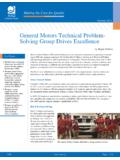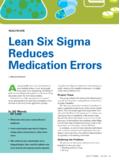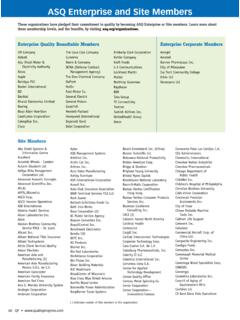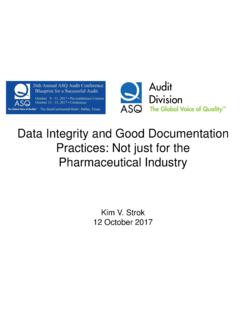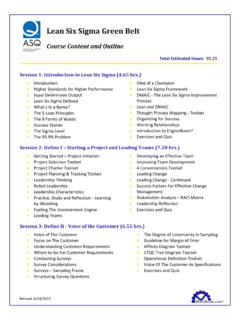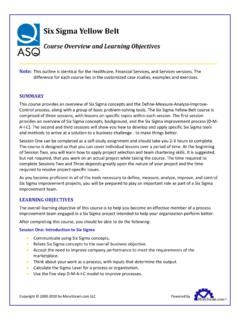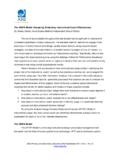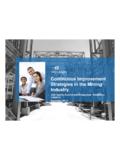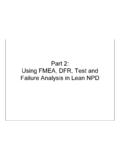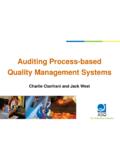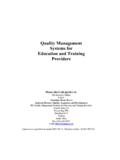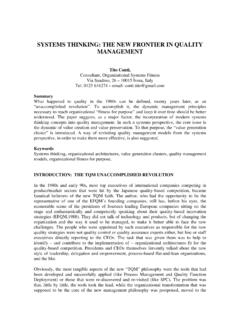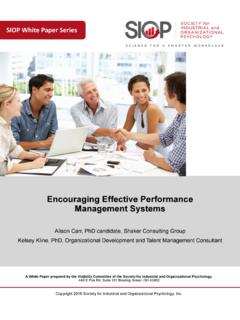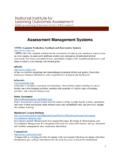Transcription of Auditing Process-based Quality Management Systems
1 Auditing Process-based Quality Management Systems Part 2 Charlie Cianfrani and Jack West C. A. Cianfrani & J. E. West January, 2013 C. A. Cianfrani & J. E. West January, 2013 Agenda Course objectives Introductions What is an audit How to prepare for and plan an audit How to conduct an audit How to report on an audit Course closing C. A. Cianfrani & J. E. West January, 2013 Conducting An Audit Conduct opening meeting Examine records Observe activities Interview people Analyze data Form conclusions Conduct closing meeting C.
2 A. Cianfrani & J. E. West January, 2013 Conducting An Audit Two basic aspects: process -related aspect personal characteristics C. A. Cianfrani & J. E. West January, 2013 process -related Aspects Hold an opening meeting Observe processes Observe process outputs, including final product, if applicable Ask questions Gather objective evidence Keep great notes. Analyze objective evidence Synthesize all that is seen and heard; draw conclusions Hold a closing meeting C.
3 A. Cianfrani & J. E. West January, 2013 Opening Meeting Introduce all parties Review the audit objectives and scope Determine the general flow and assignments for data gathering (who will be with whom and when) Make arrangements for a closing meeting Review safety concerns Review housekeeping and communications (escorts, briefings, etc.) C. A. Cianfrani & J. E. West January, 2013 Observe the process Quality Quality Quality Quality Policy Quality Objective Quality Objective Quality Objective Output Input Activity Activity Activity process Controls Resources Objectives Aligned?
4 C. A. Cianfrani & J. E. West January, 2013 Observe process Outputs Do they meet customer requirements? Do they meet the organization s objectives for the process ? C. A. Cianfrani & J. E. West January, 2013 Observe the process Interactions Controls Resources Output Input Activity Activity Activity Examples Do people in the process have the time, knowledge, and tools needed? Are appropriate controls in place to ensure requirements and objectives are met? Calibration process Input Output Records Control process Training process Input Input Maintenance process C.
5 A. Cianfrani & J. E. West January, 2013 Do we have a controlled process ? Are the requirements for successful completion of work clear? How do individuals know that they have performed work to requirements? Are process or product metrics in place and being used? What is done with data that are collected related to the product or process ? Who analyzes it? For what purpose? Is there evidence of use of the analyzed data? How is continual improvement addressed for the activity being observed?
6 C. A. Cianfrani & J. E. West January, 2013 Observe the process When things go wrong: What are the processes for: Correction Control of nonconforming product Disposition of nonconforming product Analysis for possible corrective action When things go right: Are any best practices captured and shared? C. A. Cianfrani & J. E. West January, 2013 Ask Questions Questioning by: Closed questions How long have you worked here? What time is it? Open questions How do you.
7 ? Why do you ..? When do you ..? C. A. Cianfrani & J. E. West January, 2013 Auditors Ask Questions ? And auditees answer them! C. A. Cianfrani & J. E. West January, 2013 Information auditors actually need Facts supported by credible data Credible data = objective evidence C. A. Cianfrani & J. E. West January, 2013 Getting Facts and Supporting Data By Observation of process activities Asking the same questions of several individuals Asking for objective evidence for everything Looking for normal variability in process performance Looking for consistency in records C.
8 A. Cianfrani & J. E. West January, 2013 Verify the Facts Look for alignment of process understanding by workers Consistency between answers to questions, data and records Extend sample when you spot potential problems C. A. Cianfrani & J. E. West January, 2013 Keep Great Notes One can never have too many notes Note the names of people with whom you interacted with during the audit Note report names and numbers (as applicable) Note objective evidence reviewed Be especially careful to have good notes if any deviations from requirements are observed C.
9 A. Cianfrani & J. E. West January, 2013 Analyze Think while you are Auditing ; ask yourself: What am I seeing? Is this process operating under controlled conditions? How do I know? What are the data telling me? Are the charts on the wall consistent with what I am observing? Etc., etc., etc. C. A. Cianfrani & J. E. West January, 2013 Synthesize Put all the inputs together to reach a conclusion: Is there evidence of failure to meet requirements? A single isolated event or is it systemic?
10 Any connections to other processes and applications? Are there any areas that should be noted for consideration of action to improve performance? Are there any best practices that can be suggested for consideration by other areas of the enterprise? Are there any individuals or group that merit special recognition? C. A. Cianfrani & J. E. West January, 2013 The Closing Meeting A closing meeting should include: Restatement of the audit s scope and objectives Conclusions overall opinion on the application of the Quality Management system within the processes and areas audited Any positive practices observed Failures to comply with requirements, and whether such occurrences were isolated or systemic C.
